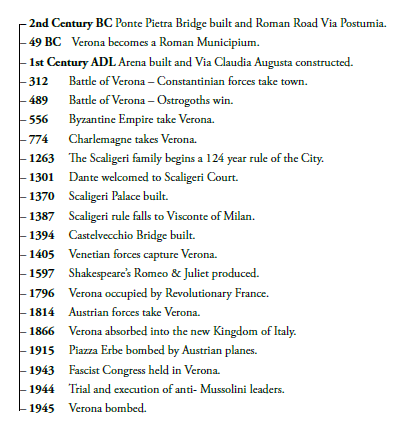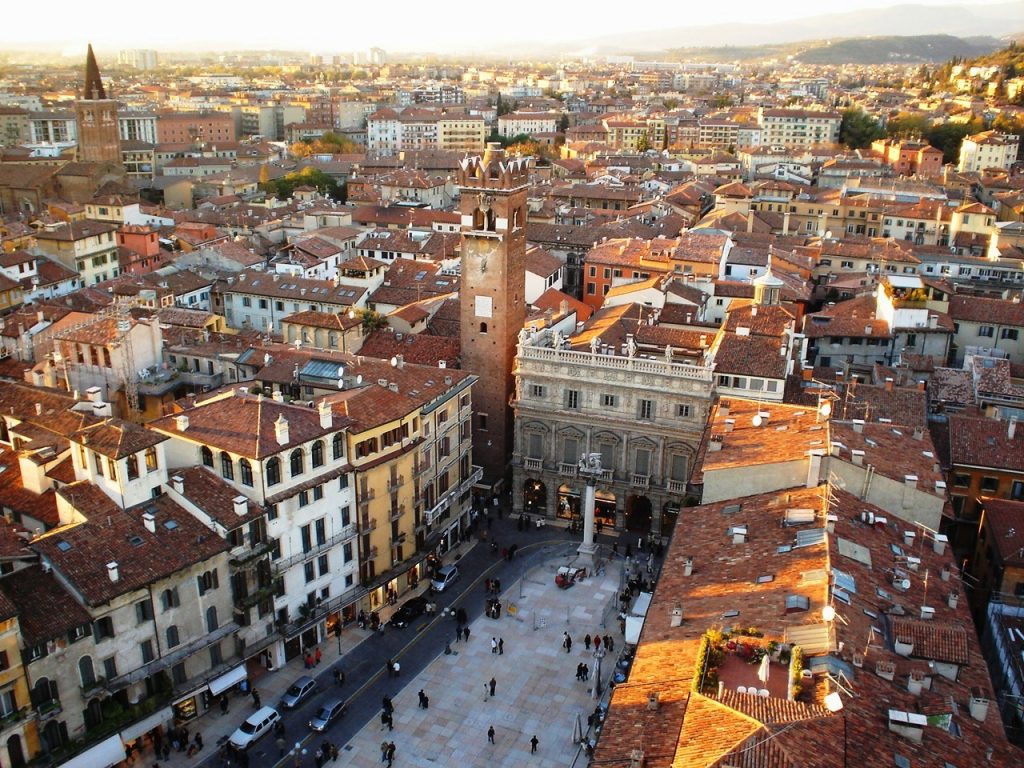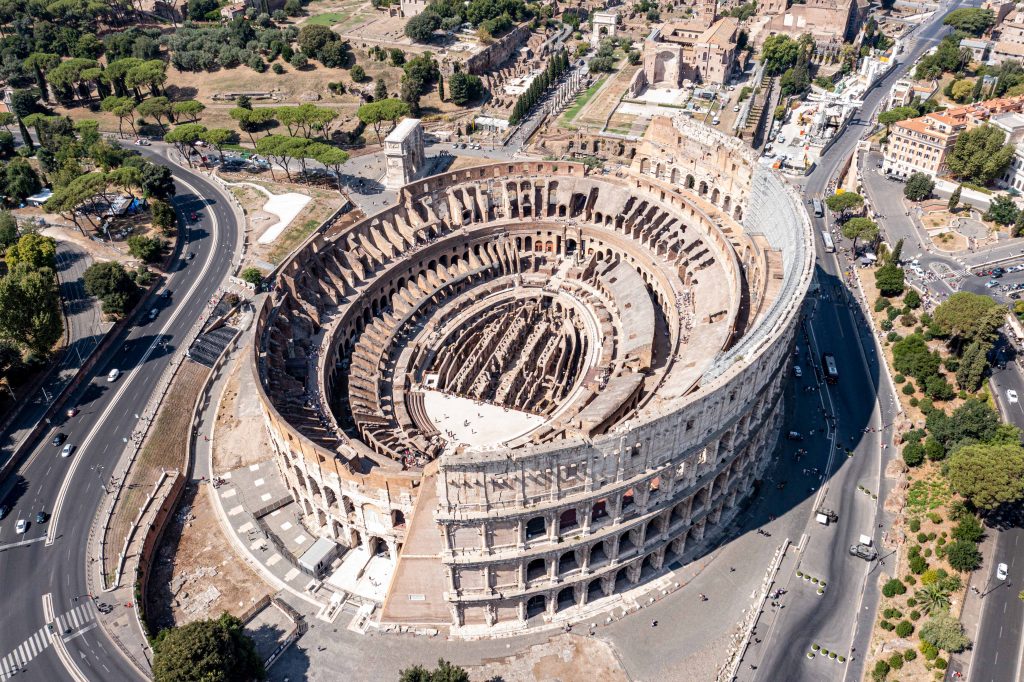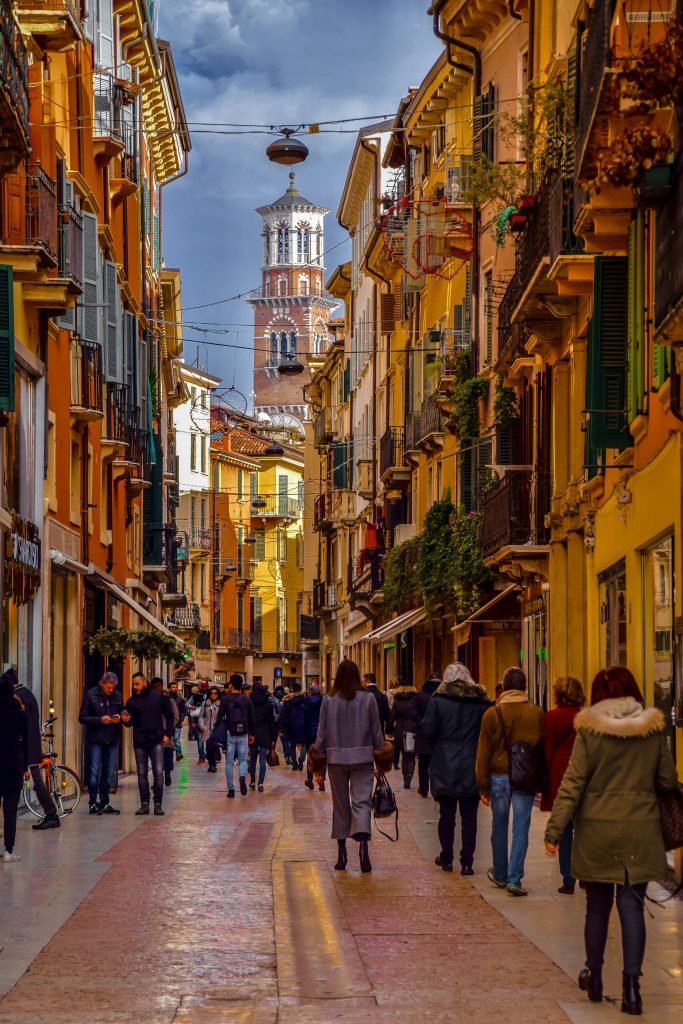
VERONA: THE LITTLE ROME
“There is no world without Verona Walls,
quote written on plaque beneath bust of Shakespeare near Piazza Bra
but Purgatory, torture, Hell itself ”
Verona – perhaps over-shadowed a little by its near neighbour Venice – is an interesting place to visit for a weekend, or longer if you use it as a base (cheaper than Venice) to explore its neighbour, as well as Padua and Vicenza, with a side trip to Lake Garda; all are within an hour of the main railway station. The Airport is only 20 minutes away by taxi and the main station, Verona Porta Nuova, is a 15 minute walk up into the City, which itself is completely walkable. I stayed at the Hotel Indigo, a very short walk through the arch into the Piazza Bra and thence to the Piazza Erbe. The City is bisected by the Adige River and has many bridges of different eras, all reconstructed from the debris in the river after the retreating Germans blew them up in 1945. Verona is a blend of Roman and Renaissance architecture with Castles and magnificent Churches thrown in.


Strolling through Verona is like a walk through history. The city is a Unesco Heritage site reflecting, its 2,000-year history with a few interesting claims to fame. It is home to the oldest library in the world – the Capitular Library, containing 1,200 ancient manuscripts, 268 incunabula and 11,000 parchments including the Institution of Gaius, a complete text of Roman Law (visiting by appointment) – and the first Arena in the world, older than the Colosseum and built as a prototype in 30AD, now used as a spectacular setting for Summer Operas. The capacity of 30,000 attracts citizens from all over Northern Italy.
“ … Most Italian Place On Earth” is the slogan of the Arena di Verona.
The walls and gates surrounding the town are also impressive, including up into the hills above the city – built by the Romans, rebuilt in the 12th century, extended in the 14th century, partly destroyed by Napoleonic forces and then re- built by the Austrians.
Verona was the birthplace of some well known Romans; Pliny the naturalist, Catulus the poet and Vitruvius the architect, all commemorated with statues in the Piazza Dei Signori.


The other international claim to fame is the association with Shakespeare, and in particular with Romeo and Juliet (The Two Gentlemen of Verona takes second place). In the 1550s Verona would have been well-known to Elizabethans as a place of learning, as well as a place in common with many contemporary Italian Papal and other City States where powerful families vied for power; so ideal for Shakespeare, although there is no record of him ever visiting. The Houses of Dal Caprelo (derived into the Capulet family) and House of Montague, both of which existed and competed for prominence, were a perfect match for the saga. The feuding of the families is referred to by Dante in the 1300s – the Cappalletti vs the Montecchi. Casse di Guillette, Juliet’s home, with its family shield on the building and the balcony (a 17th century addition using a sarcophagus) was a stone’s throw away from Romeo’s home – you can visit the former down a small alleyway off Via Cappello. The story and mix of reality and myth is to be taken with a pinch of salt, as are the historical representations of the modern day.
If you enjoy food and wine then you are in for a treat, it is not as varied as Bologna, but close. Being in the Veneto wine area you have the wonderful Amarone reds and Soave whites to savour with your Gnocchi di San Zeno (Zeno is the patron Saint of the City – the dish is a specialty of potato-filled Gnocchi in a variety of sauces) or Risotto Amarone. Try the white Lugana wines grown on slopes of Southern Lake Garda. For those who want to try something different the horse and donkey stews are very popular here, but whilst I have eaten insects in Zimbabwe the thought of nibbling donkey doesn’t sit well!
If you enjoy a bit of shopping while you are in Verona then wander down Via Mazzini, where both men’s and ladies fashions are on view – why do Italian men dress so well? The many cobbled side streets are also packed with small specialist shops selling everything from antiques to stationery.
‘Verona is a blend of Roman and Renaissance architecture with Castles and magnificent Churches thrown in.’
Try your first foray into the City up the Corso Porta Nuova, through the arch and into a wide large Piazza, the Piazza Bra, which is flanked by cafes on the left and surrounded by municipal buildings; but the centre piece is the Arena, its appearance amplified by the wide open space in front of it. Walk north onto the Via Mazzini past all the tempting shops, turn left at the top and the street opens out into the Piazza Della Erbe, once the location of the Roman Forum, now named after the old herb market; a market still operates within the Piazza. It is a great people-watching place with cafes along the right-hand side, and surrounded by interesting buildings; the facing Mazzanti Houses are frescoed and it houses the ancient Town Hall, with the Palazzo Maffei and its Greek Gods decoration to one side. The tall marble column towards the north in the centre is topped by St. Mark’s Lion, the symbol of the Republic of Venice (Venice absorbed the City in 1405). Medieval Tower Houses surround the Piazza and a small fountain in the centre is interesting. The statue in the centre of the fountain is Roman, c. 300AD, depicting Verona as a Madonna; she holds a scroll which reads, “Verona is a city that provides justice and loves to be praised”. This was the original motto of the City, the fountain being built by Cansignorio, the last of the Della Scala clan in 1368.


If you carry on north you reach the Duomo on the banks of the Adige, worth a visit, built in 1139, with Titian’s Assumption being the highlight of the interior. Turning right along the banks of the river and crossing at the Ponte Pietro you are faced by the Roman theatre and above the Castle of San Pietro. You can walk up the steps or take the short funicular train to the top. From here you get a splendid view of the City, looking directly down on the bridge, which was built in 100BC as part of the main road between Genoa and Aquileia, rebuilt in 1298 and again after WW2 all using original materials.
Verona has numerous churches to visit, but I will talk about one in particular which is a must-see. It is a little way outside the main city but easily walkable, and you pass several interesting places en route. From the Piazza Bra take the Via Roma to the Castelvecchio, a large castle on the left bank of the river, built between 1355 and 1375 and containing an art gallery, including Veronese’s Deposition. Cross the Ponte Scaligeri, an unusual fortified bridge built at the same time as the castle, to the City arsenal then along the river to cross back at the next bridge. You are heading for the Piazza San Zeno.
In this square of low buildings the Basilica di San Zeno, flanked by the Church of St. Procolo, stand out, with their Romanesque architecture and Bell Tower. Built around the 10th century originally and added to throughout the next two centuries, apart from the beauty of the buildings the crypt is supposed to be where Romeo and Juliet married. Inside is the sarcophagus containing San Zeno, with his face covered with a silver mask and a representation of his face to the right. He died in the 370s. Of note are the 11th century main bronze doors with 48 panels.
My two favourite places in Verona are the Chiesa di San Fermo on the right bank of the river and the Giardino Giusti on the other side of the river, not far from the Castle San Pietro. Off a small back street hidden away are the gardens: Thomas Coryate, an English traveller in 1611 described it as “a second paradise”, and some time later John Evelyn, the diarist, thought it the finest garden in all of Europe. Go! It is a change from the closeness of the city’s streets. My all-time best place with a wow factor is the off-the-beaten-track church of San Fermo, built to honour two Christian Martyrs – Fermo and Rustico – on the spot where they were tortured to death by the Romans. The church is a mix of different periods, originally built during the 5th and 6th centuries, but transformed by the Franciscans who in the 1350s created a wonderful, mind-boggling, huge wooded ceiling in the shape of an upturned boat, complete with over 400 small paintings of saints inset as panels in the structure.
To conclude, Verona is a City full of history, so if that is what you enjoy then go for a weekend, or even for a day from Venice.
By Tim Robson
